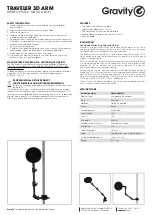
SECTION 4
MAINTENANCE AND CALIBRATION
PREVENTIVE MAINTENANCE
Visual Inspection
The Type 1 LI 0 Spectrum Analyzer should be inspected
occasionally for such visible defects as poor connections,
broken or damaged ceramic strips, improperly seated tubes
or transistors, and heat-damaged parts. The remedy for most
visible defects is obvious; however, particular care must
be taken if heat-damaged parts are detected. Overheating
can be caused by other, less apparent defects in the circuit.
For this reason, it is essential to determine the actual cause
of overheating before the parts are replaced; otherwise
the damage may be repeated.
Recalibration
The Type 1 L I0 Spectrum Analyzer is a highly stable instru
ment and needs no recalibration except in the event the
instrument fails to perform to the requirements specified in
Section 1 of this manual. In the event of a failure of the
instrument, first perform the Checkout Procedure described
later in this section of the manual. This w ill serve to either
localize the trouble or point out the need for recalibration.
PARTS REMOVAL A N D REPLACEMENT
General Information
Removal or replacement procedures for most o f the parts
in the Type
1 LI 0 are obvious. Some parts, however, re
quire special instructions regarding their replacement. These
parts are discussed in the following paragraphs.
Many components in the Type 1 LI0 are mounted in a
particular way to control stray inductance and capacitance.
When replacing this type o f component, take care to
duplicate lead length, lead dress, and location of the original
component.
After replacing any electrical component, be sure to per
form the Checkout Procedure. Components of the same type
often exhibit slightly different characteristics which may
affect calibration.
Tubes and Transistors
The tubes or transistors in the Type 1 LI 0 should not be
replaced unless they are actually defective. When a tube
or transistor is removed and found acceptable, return the
component to its original socket. This w ill avoid recalibration
because of different tube or transistor characteristics.
The best w ay to check a tube or transistor is by substituting
another tube or transistor of the same type that is of
known good quality. Then check to see if proper operation
is restored. If not, replace the original tube or transistor in
its socket.
Soldering Precautions
In the production of Tektronix instruments, a silver-bearing
solder is used to establish a bond to the ceramic terminal
strips. This bond can be broken by repeated use of ordinary
tin-lead solder or by excessive heating of the connection in
the solder process. Occassional use of ordinary tin-lead
solder is permissible if applied with moderate heat. The
silver-bearing solder should contain about 3% silver. If this
type of solder is not available locally, it may be purchased
from Tektronix in one-pound rolls (order by part number
251-0514-00).
A wedge-shaped tip on the soldering iron is best for
soldering and unsoldering parts on the ceramic strip. This
type of tip allows the heat to be applied directly to the
solder slot in the strip, reducing the overall heating effect.
Use as little heat as possible to establish a good solder
bond.
To properly solder and unsolder short lead components,
the following procedure is recommended: (1) Use long-nose
pliers for a heat sink. Attach the pliers between the com
ponent and the point being soldered. (2) Use a hot iron for
a short time. (3) Carefully manipulate the leads to prevent
lead or insulation damage. (4) Use only a small amount of
solder; just enough to make a good bond.
Ceramic Terminal Strips
To remove a ceramic terminal strip, first unsolder all leads
and components connected to it. Then pry the strip, with
yokes attached, out o f the chassis. The spacers may come
out with the yokes. If not, the spacers can be pulled out
separately. If the spacers are not damaged, they can be
reused with the new strip assembly.
Another way to remove a strip from the chassis is to use
diagonal cutters to cut o ff one side of each yoke. This
frees the strip and the remainder o f the yokes can be pulled
from the chassis separately. Ceramic strips are supplied
with the yokes attached, so it is not necessary to salvage
the old yokes.
After removing a damaged strip and yokes, place the
spacers into the holes in the chassis and insert the yokes into
the spacers. If necessary, use a soft-faced mallet to tap the
yokes into the spacers. Fig. 4-1 shows the assembled ceramic
strip.
Schematics
The schematics of the Type 1 LI 0 are at the back of this
manual. The schematics contain waveforms and voltages at
certain points in the circuit that w ill aid in troubleshooting
or in analyzing the circuit operation.
If it is necessary to duplicate any o f the voltages or wave
forms, be sure to read the special note on the schematics
regarding the proper conditions. The voltages and wave
forms on the schematics are typical only, and may vary
w idely from instrument to instrument.
Summary of Contents for 1L10
Page 4: ...Type 1L10 Spectrum Analyzer Plug In Unit Type 1LI 0 ...
Page 6: ...NOTES ...
Page 10: ...NOTES ...
Page 12: ...Fig 3 1 Block diagram of the Type 1L10 CO to Theory of Operation Type 1 LI 0 ...
Page 16: ...NOTES ...
Page 34: ...NOTES ...
Page 36: ...Parts List Type 1LI 0 EXPLODED VIEW 5 2 ...
Page 62: ... T Y P E 1LIO SPECTRUM ANALYZER B VARIABLE RESOLUTION AMPLIFIER VARIABLE RESOLUTION AMPLIFIER ...
Page 71: ...Type 1L10 Page 2 of 2 Schematic Correction PARTIAL VAR RESOLUTION AMR m i o 081 1165 ...
















































